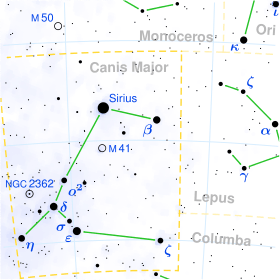Gamma Canis Majoris

| |
| Observation data Epoch J2000.0 Equinox J2000.0 | |
|---|---|
| Constellation | Canis Major |
| Right ascension | 07h 03m 45.49305s[1] |
| Declination | −15° 37′ 59.8300″[1] |
| Apparent magnitude (V) | +4.10[2] |
| Characteristics | |
| Spectral type | B8II[3] |
| U−B color index | −0.45[2] |
| B−V color index | −0.13[2] |
| Astrometry | |
| Radial velocity (Rv) | +32.0[4] km/s |
| Proper motion (μ) | RA: −0.14[1] mas/yr Dec.: –11.36[1] mas/yr |
| Parallax (π) | 7.38 ± 0.21[1] mas |
| Distance | 440 ± 10 ly (136 ± 4 pc) |
| Absolute magnitude (MV) | −1.4[5] |
| Details | |
| Radius | 5.6[6] R☉ |
| Surface gravity (log g) | 3.5[6] cgs |
| Temperature | 13,596[6] K |
| Metallicity [Fe/H] | −0.24[7] dex |
| Rotation | 6.16 d[8] |
| Rotational velocity (v sin i) | 30[9] km/s |
| Other designations | |
| Database references | |
| SIMBAD | data |
Gamma Canis Majoris (γ Canis Majoris, abbreviated Gamma CMa, γ CMa), also named Muliphein,[10] is a star in the constellation of Canis Major. It is unclear exactly why this relatively faint star was given the 'gamma' designation, but possibly because it is in the same part of the constellation as Sirius (alpha) and Mirzam (beta).
Nomenclature
γ Canis Majoris (Latinised to Gamma Canis Majoris) is the star's Bayer designation.
It bore the traditional name Muliphein,[11] not to be confused with Muhlifain, which is Gamma Centauri; both names derive from the same Arabic root, محلفين muħlifayn. In 2016, the International Astronomical Union organized a Working Group on Star Names (WGSN)[12] to catalogue and standardize proper names for stars. The WGSN approved the name Muliphein for this star on 21 August 2016 and it is now so entered in the IAU Catalog of Star Names.[10]
Properties
Gamma Canis Majoris is a blue-white B-type bright giant with a stellar classification of B8II[3] and an apparent magnitude of +4.11. It is approximately 440 light years from Earth. It is a chemically peculiar Hg-Mg star displaying abnormal lines of mercury and magnesium.[8] This star has 5.6 times the radius of the Sun and the outer atmosphere has an effective temperature of 13,596 K.[6]
This star is suspected of being a spectroscopic binary system, and there is a candidate companion at an angular separation of 0.332″ along a position angle of 114.8°.[8] It is a member of the Collinder 121 open cluster.[13]
Modern legacy
Muliphein appears on the flag of Brazil, symbolizing the state of Rondônia.[14]
References
- 1 2 3 4 5 van Leeuwen, F. (2007), "Validation of the new Hipparcos reduction", Astronomy and Astrophysics, 474 (2): 653–664, arXiv:0708.1752
 , Bibcode:2007A&A...474..653V, doi:10.1051/0004-6361:20078357.
, Bibcode:2007A&A...474..653V, doi:10.1051/0004-6361:20078357. - 1 2 3 Fernie, J. D. (May 1983), "New UBVRI photometry for 900 supergiants", Astrophysical Journal Supplement Series, 52: 7–22, Bibcode:1983ApJS...52....7F, doi:10.1086/190856.
- 1 2 Buscombe, W. (1962), "Spectral classification of Southern fundamental stars", Mount Stromlo Observatory Mimeogram, 4, Bibcode:1962MtSOM...4....1B.
- ↑ Kharchenko, N. V.; et al. (2007), "Astrophysical supplements to the ASCC-2.5: Ia. Radial velocities of ∼55000 stars and mean radial velocities of 516 Galactic open clusters and associations", Astronomische Nachrichten, 328 (9): 889, arXiv:0705.0878
 , Bibcode:2007AN....328..889K, doi:10.1002/asna.200710776.
, Bibcode:2007AN....328..889K, doi:10.1002/asna.200710776. - ↑ Jaschek, C.; Gomez, A. E. (1998). "The absolute magnitude of the early type MK standards from HIPPARCOS parallaxes". Astronomy and Astrophysics. 330: 619. Bibcode:1998A&A...330..619J.
- 1 2 3 4 Underhill, A. B.; et al. (November 1979), "Effective temperatures, angular diameters, distances and linear radii for 160 O and B stars", Monthly Notices of the Royal Astronomical Society, 189 (3): 601–605, Bibcode:1979MNRAS.189..601U, doi:10.1093/mnras/189.3.601.
- ↑ Searle, Leonard; et al. (July 1966), "Studies of the Peculiar a Stars.IV. The Relative Abundances of Four Iron-Peak Elements", Astrophysical Journal, 145: 141, Bibcode:1966ApJ...145..141S, doi:10.1086/148750.
- 1 2 3 Hubrig, S.; et al. (November 2012), "Magnetic fields of HgMn stars*", Astronomy & Astrophysics, 547: 24, arXiv:1208.2910
 , Bibcode:2012A&A...547A..90H, doi:10.1051/0004-6361/201219778, A90.
, Bibcode:2012A&A...547A..90H, doi:10.1051/0004-6361/201219778, A90. - ↑ Abt, Helmut A.; et al. (July 2002), "Rotational Velocities of B Stars", The Astrophysical Journal, 573 (1): 359–365, Bibcode:2002ApJ...573..359A, doi:10.1086/340590.
- 1 2 "IAU Catalog of Star Names". Retrieved 28 July 2016.
- ↑ Star Name - R.H.Allen p.130
- ↑ IAU Working Group on Star Names (WGSN), International Astronomical Union, retrieved 22 May 2016.
- ↑ Maza, N. L.; et al. (October 2010), "Atomic species in the spectrum of the Hg-Mn star HD 53244", Revista Mexicana de Astronomía y Astrofísica, 46: 339−348, Bibcode:2010RMxAA..46..339M.
- ↑ "Astronomy of the Brazilian Flag". FOTW Flags Of The World website.